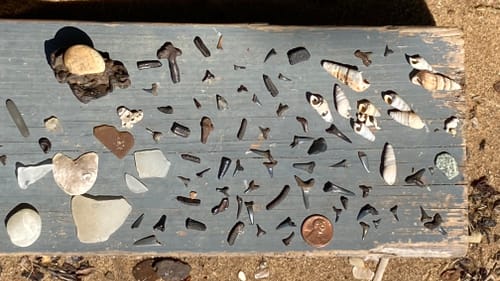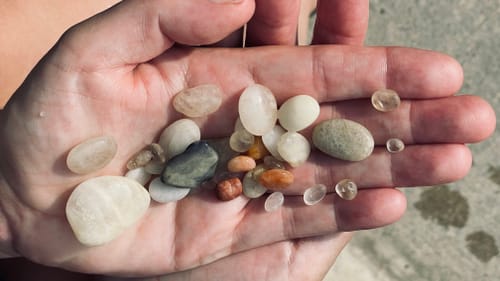Stay in the Loop
BSR publishes on a weekly schedule, with an email newsletter every Wednesday and Thursday morning. There’s no paywall, and subscribing is always free.
Hit the road (or the river) to discover fossils, Jersey diamonds, and petroglyphs
Three free road trips from Philadelphia offer a treasure-hunting trifecta

Looking for a day trip treasure-hunting trifecta? Three free road trips within about three hours of Philadelphia involve three different kinds of unique stone treasures, creating the perfect trio of day trips for adventurous families and friends.
Purse State Park fossils
First is Purse State Park, part of the Nanjemoy Wildlife Management Area in Maryland. It is located along the Potomac River at Wades Bay. Visitors will find a short, narrow sand/pebble beach suitable for swimming and fishing (with the proper license). The main attraction, however, is collecting fossilized shark teeth.
Plan on arriving shortly before low tide since that is when most of the beach area will be exposed for searching. Limited parking is available in a small lot across the road from the one-quarter-mile path that leads to the beach. Bringing a sieve and a small scoop will make finding fossils much easier, though sometimes you can spot them lying on the surface as you walk along the beach. There are no amenities, so plan your bathroom breaks accordingly. Pack a lunch or pick up sandwiches and drinks at the nearby Grey Brothers store and deli.

Sunset Beach "diamonds"
Sunset Beach in Cape May, New Jersey, is a bit closer to Philly. This site offers a variety of activities for the entire family. Besides the spectacular sunsets, visitors can view the remains of the SS Atlantus, a concrete ship designed to be used during WWI that ran aground off the beach in 1926.
History buffs may also tour the nearby WWII fire-control tower. Its purpose was to triangulate the positions of potential enemy ships and submarines in the Delaware Bay and call in artillery strikes from the coastal defense batteries. (The historic Cape May Lighthouse offers an aerial view of it all.)
During the Sunset Beach summer season, visitors may swim, fish (with the proper license), peruse the gift shop, play minigolf, or grab a bite to eat at The Grille (or the nearby Lobster House if you love seafood). Be sure to stay for the flag-lowering ceremony honoring our nation’s veterans.

For treasure hunters, the excitement begins with searching for Cape May Diamonds, which are pure quartz crystals that have washed down the Delaware River over hundreds of years. The wreck of the SS Atlantus helps wash the crystals ashore. The stones come in a variety of sizes, colors, and shapes and are easily spotted. While many are naturally clear, polishing them in a rock tumbler yields impressive results. Cape May Diamonds that have been faceted and set in jewelry are available in the gift shop.
Safe Harbor petroglyphs
The third day trip, about two hours from Philadelphia, leads to Safe Harbor, Pennsylvania, where visitors can search for 1,000-year-old petroglyphs made by our region’s Indigenous people. These rock carvings, accessible only by boat, are located on islands in the middle of the Susquehanna River downstream from the Safe Harbor Dam. You’ll need a watercraft to view these mysterious carvings.
Kayaks, canoes, or stand-up paddle boards may be launched from the Conestoga River Park and paddled approximately one half-mile downstream. Power boats may be launched from the Pequea boat launch for the two-mile upstream trip. Fishing is permitted (with the proper license).
The islands you seek are aptly named Big Indian Rock and Little Indian Rock. Big Indian Rock, a large, gray, gently down-sloping rock with minimal vegetation is hard to miss. Little Indian Rock is about 100 yards upstream.
Little Indian Rock contains the largest concentration of Native American petroglyphs along the East Coast. Images include thunderbirds, the god-like Manitou, anthropomorphic humans/animals, birds, four-legged animals, life-sized animal tracks of turkey, elk, bear, and even a human footprint. Wavy serpent lines mark the location of sunset on the summer solstice and sunrise on the winter solstice.

The petroglyphs remain an enigma. Do they have religious significance? Are they a teaching tool? A map? A calendar? Or are they a combination of all these things?
The best viewing times are near sunrise or sunset when the sun’s slanting rays shadow the edges of the carvings, making them pop. Wetting a sponge and stamping around the carvings make them easier to view as does pouring water directly on them. Bring an empty milk jug, sponges, and a camera to record your discoveries (or your phone in a waterproof pouch). Additional petroglyphs may be found on some of the smaller nearby islands.
Water conditions may vary greatly depending on whether the hydroelectric dam is releasing water. If orange warning lights and sirens sound on the dam, it is advised to leave the area.
Whether your idea of adventure involves finding fossil shark teeth, searching for Cape May Diamonds, or viewing petroglyphs, this treasure-hunting trifecta of road trips offers something for everyone looking for a Philly-area getaway this summer.
At top: a trip down the Susquehanna River reveals centuries-old petroglyphs. (Photo courtesy of Bart Stump and Jenn Schiding.)
Sign up for our newsletter
All of the week's new articles, all in one place. Sign up for the free weekly BSR newsletters, and don't miss a conversation.

 Bart Stump
Bart Stump